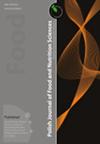吡啶甲酸铬和纳米铬颗粒添加到低脂肪或高脂肪饮食中对大鼠体内铬生物分布和血液中某些矿物质水平的影响
IF 2.3
4区 农林科学
Q3 FOOD SCIENCE & TECHNOLOGY
引用次数: 4
摘要
磷锌相互作用,其缺乏或过量积累可能导致各种紊乱,包括贫血和糖尿病。目前的研究旨在确定添加吡啶甲酸(CrPic)或纳米颗粒(CrNPs)形式的Cr(III)的低脂或高脂饮食是否对该元素在器官中的保留和积累以及大鼠血浆中P、Ca、Fe、Cu和Zn的含量具有交互作用。该实验使用48只雄性Wistar大鼠进行,该大鼠喂食低脂肪或高脂肪半纯化大鼠饮食,饮食中添加0.3 mg/kg体重的铬。所获得的结果表明,膳食Cr形式对这种微量元素的排泄模式至关重要。已经发现,与CrPic相比,CrNPs在更大程度上通过尿液和粪便从大鼠体内排出,如Cr保留指数的值所示(分别为44.4%和65.9%)。额外的膳食Cr,无论其形式和饮食类型如何,都没有在分析的内脏中积累,即大脑、脾脏、肾脏、肝脏、大腿骨和大腿肌肉。需要强调的是,与CrNP不同,添加到高脂肪饮食中的膳食CrPic与喂食低脂饮食的大鼠相比,会降低重要矿物质的血浆浓度,即Zn(60.5 vs.69.9µM)、Cu(13.6 vs.15.7µM)和P(1.12 vs.1.30µM)。反过来,添加到高脂肪饮食中的CrNP(而不是CrPic)降低了血浆Fe水平(1.41对2.43µM)。本文章由计算机程序翻译,如有差异,请以英文原文为准。
Effect of Chromium Picolinate and Chromium Nanoparticles Added to Low- or High-Fat Diets on Chromium Biodistribution and the Blood Level of Selected Minerals in Rats
phosphorus zinc interconnected, and their deficiency or excessive accumulation may lead to various disturbances, including anemia and diabetes. The current research was undertaken to determine whether low-fat or high-fat diets with the Cr(III) addition in the form of picolinate (CrPic) or nanoparticles (CrNPs) have an interactive effect on the retention and accumulation of this element in organs and the content of P, Ca, Fe, Cu and Zn in the blood plasma of rats. The experiment was performed using 48 outbred male Wistar rats fed a low-fat or high-fat semi-purified rat diet with dietary addition of chromium at a dose of 0.3 mg/kg body weight. The obtained results point to the paramount importance of the dietary Cr form on the excretion pattern of this microelement. It has been found that CrNPs were to a greater extent excreted from the rat’s body via urine and feces in comparison to CrPic, as indicated by the val - ues of the Cr retention index (44.4 vs. 65.9%, respectively). The additional dietary Cr, irrespective of its form and diet type, was not accumulated in the analyzed internal organs, i.e. brain, spleen, kidneys, liver, thigh bone, and thigh muscle. It should be stressed that dietary CrPic, unlike CrNPs, added to the high-fat diet adversely reduced plasma concentration of vital minerals in comparison to the levels observed in rats fed the low-fat diet, i.e. Zn (60.5 vs. 69.9 µM), Cu (13.6 vs. 15.7 µM), and P (1.12 vs. 1.30 µM). In turn, the CrNPs, but not CrPic, added to the high-fat diet decreased plasma Fe level (1.41 vs. 2.43 µM).
求助全文
通过发布文献求助,成功后即可免费获取论文全文。
去求助
来源期刊

Polish Journal of Food and Nutrition Sciences
FOOD SCIENCE & TECHNOLOGY-
CiteScore
4.30
自引率
12.50%
发文量
25
审稿时长
20 weeks
期刊介绍:
The Polish Journal of Food and Nutrition Sciences publishes original, basic and applied papers, reviews and short communications on fundamental and applied food research in the following Sections:
-Food Technology:
Innovative technology of food development including biotechnological and microbiological aspects
Effects of processing on food composition and nutritional value
-Food Chemistry:
Bioactive constituents of foods
Chemistry relating to major and minor components of food
Analytical methods
-Food Quality and Functionality:
Sensory methodologies
Functional properties of food
Food physics
Quality, storage and safety of food
-Nutritional Research Section:
Nutritional studies relating to major and minor components of food (excluding works related to questionnaire
surveys)
-“News” section:
Announcements of congresses
Miscellanea
 求助内容:
求助内容: 应助结果提醒方式:
应助结果提醒方式:


